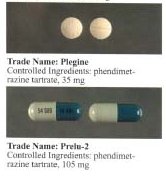 | |
 | |
| Clinical data | |
|---|---|
| Trade names | Bontril |
| Other names | Mephenmetrazine; (2S,3S)-3,4-Dimethyl-2-phenylmorpholine |
| AHFS/Drugs.com | Monograph |
| Routes of administration | Oral administration |
| ATC code |
|
| Legal status | |
| Legal status |
|
| Pharmacokinetic data | |
| Bioavailability | Peak plasma levels occur within 1 to 3 hours. Absorption is usually complete by 4 to 6 hours |
| Metabolism | Liver |
| Elimination half-life | 19-24 hours |
| Excretion | Urinary elimination |
| Identifiers | |
| |
| CAS Number | |
| PubChem CID | |
| DrugBank | |
| ChemSpider | |
| UNII | |
| KEGG | |
| ChEMBL | |
| CompTox Dashboard (EPA) | |
| ECHA InfoCard | 100.010.186 |
| Chemical and physical data | |
| Formula | C12H17NO |
| Molar mass | 191.274 g·mol−1 |
| 3D model (JSmol) | |
| |
| |
| (verify) | |
Phendimetrazine, sold under the brand name Bontril among others, is a stimulant medication of the morpholine chemical class used as an appetite suppressant. [2]

